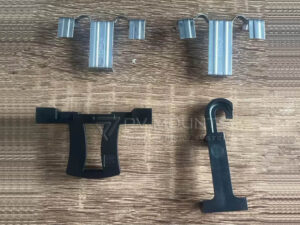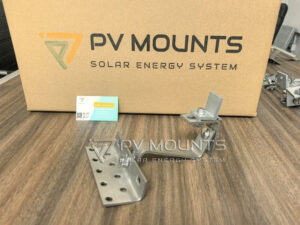Dans le domaine des systèmes d'énergie solaire, chaque composant joue un rôle essentiel pour garantir l'efficacité et la durabilité de l'investissement. Parmi ceux-ci, les colliers à joint debout sont essentiels, car ils permettent de fixer les panneaux solaires sur les toits sans pénétrer dans le matériau de couverture. Cela permet non seulement de préserver l'intégrité structurelle, mais aussi d'améliorer la longévité de la toiture et des panneaux solaires. Cet article explore l'impact substantiel des colliers à joint debout sur les panneaux solaires, en se concentrant sur leur conception, leurs avantages et les éléments essentiels à prendre en compte lors de l'installation.
Les principes de base des pinces à sertir
Qu'est-ce qu'une pince à joint debout ?
Les pinces pour joints debout sont des solutions de montage non invasives utilisées pour fixer les panneaux solaires aux joints métalliques des toits. Ces pinces sont conçues pour se fixer fermement aux joints surélevés, éliminant ainsi la nécessité de percer des trous, ce qui peut entraîner des fuites potentielles et compromettre la structure. Leur principal intérêt réside dans leur capacité à préserver l'intégrité de la toiture tout en fournissant un système de support robuste pour les installations solaires.
Comment fonctionnent-ils dans les installations solaires ?
La fonction des pinces à joint debout dans les installations solaires est simple mais très efficace. En se fixant sur les joints verticaux d'une toiture métallique, ils fournissent un point d'ancrage solide pour les panneaux solaires. Cette méthode garantit la sécurité et la stabilité de l'installation, capable de résister à diverses conditions environnementales sans endommager la surface du toit. En outre, la facilité d'installation et de retrait de ces pinces en fait un choix privilégié pour les projets solaires résidentiels et commerciaux.
Impact sur la longévité
Améliorer la durabilité des panneaux solaires grâce aux pinces à joint debout
On ne saurait trop insister sur l'impact direct des colliers à joint debout sur la durabilité des panneaux solaires. En éliminant le besoin de pénétrer dans le toit, ces colliers réduisent considérablement le risque de problèmes courants tels que les infiltrations d'eau et l'affaiblissement de la structure. Cette mesure de protection garantit que les panneaux eux-mêmes sont moins susceptibles de rencontrer des problèmes liés aux dégâts des eaux, ce qui prolonge leur durée de vie.
Prévenir les dommages environnementaux
Les pinces à joint debout jouent également un rôle crucial dans l'atténuation des dommages causés aux panneaux solaires par l'environnement. Le fait de fixer les panneaux au-dessus du toit facilite la circulation de l'air autour des panneaux. Cette circulation d'air permet de maintenir les panneaux plus frais, réduisant ainsi le stress thermique qui peut accélérer le vieillissement et dégrader l'efficacité au fil du temps. En outre, la position surélevée protège les panneaux de l'accumulation de débris et d'eau, qui peuvent causer des problèmes physiques et électriques.
Analyse coûts-bénéfices
Coûts initiaux et économies à long terme
Lorsque l'on envisage d'utiliser des colliers pour joints debout, il est essentiel d'évaluer le coût d'un point de vue global. Au départ, ces colliers peuvent sembler plus coûteux que les méthodes de montage traditionnelles qui impliquent des pénétrations dans la toiture. Cependant, les économies à long terme qu'ils permettent de réaliser peuvent être substantielles. Ces économies se traduisent par une réduction des coûts d'entretien, une diminution des réparations dues aux dégâts des eaux et la préservation de la garantie de la toiture, qui pourrait autrement être annulée par la réalisation de trous. En outre, l'augmentation de la durée de vie des panneaux solaires et de la toiture elle-même contribue à une rentabilité significative au fil du temps.
Comparaison des coûts avec d'autres techniques de montage
Comparativement, les colliers à joint debout offrent un net avantage économique par rapport à d'autres systèmes de montage. Les techniques qui nécessitent de percer le toit ou d'y adhérer peuvent créer des points de fuite potentiels, ce qui nécessite des mesures d'étanchéité supplémentaires et des inspections régulières. Au fil du temps, ces coûts s'accumulent, sans parler du risque de réparations coûteuses en cas de dégâts des eaux. Les colliers à joint debout éliminent ces risques, ce qui en fait un choix financièrement judicieux pour les installations solaires à long terme.
Spécifications techniques
Qualité et types de matériaux
Les colliers pour joints debout sont généralement fabriqués à partir de métaux de qualité supérieure, tels que l'aluminium ou l'acier inoxydable, choisis pour leur solidité, leur durabilité et leur résistance à la corrosion. Le choix du matériau joue un rôle crucial dans la longévité et les performances de la pince, en particulier dans des conditions climatiques difficiles. Les colliers en aluminium sont légers et résistants à la corrosion, ce qui les rend idéaux pour la plupart des environnements, tandis que l'acier inoxydable offre une solidité et une durabilité accrues pour les conditions plus exigeantes.
Compatibilité avec les différents types de toits
Il est essentiel de s'assurer que les pinces à joint debout choisies sont compatibles avec le type spécifique de toiture à joint métallique sur lequel elles seront installées. Tous les colliers ne s'adaptent pas à tous les types de joints, et un mauvais choix peut entraîner une mauvaise adaptation, un maintien inadéquat et des dommages potentiels à la toiture. Une bonne compatibilité renforce non seulement la sécurité de l'installation, mais garantit également le maintien de l'intégrité de la toiture sans compromettre ses performances.
Études de cas
Exemples concrets d'amélioration de la longévité grâce à l'utilisation de pinces à joint debout
Pour illustrer l'efficacité des colliers à joint debout, prenons le cas d'un bâtiment commercial situé dans une zone côtière. Ce bâtiment subissait des tempêtes fréquentes et avait auparavant utilisé un système de montage pénétrant qui avait entraîné plusieurs cas de fuites. Après avoir adopté les colliers à joint debout, le nouveau système a non seulement résisté à un ouragan majeur, mais n'a montré aucun signe de fuite ou de dommage après la tempête, ce qui prouve la durabilité et la fiabilité des colliers non pénétrants.
Enseignements tirés
Plusieurs enseignements peuvent être tirés de cette étude et d'autres études de cas similaires :
- Sélection appropriée : Il est essentiel de choisir le bon type de collier en fonction du style et du matériau de la toiture pour maximiser l'efficacité.
- Installation professionnelle : Même les meilleures pinces ne peuvent réussir que si elles sont installées correctement. Une installation professionnelle garantit que les pinces sont correctement alignées et fixées.
- Inspections régulières : Les inspections périodiques sont essentielles, en particulier dans les environnements exposés aux intempéries, pour garantir le maintien de l'intégrité de l'installation.
Ces exemples soulignent les avantages tangibles du choix des colliers à joint debout pour les installations solaires, notamment en termes d'amélioration de la longévité du système et de réduction des problèmes de maintenance.
Maintenance et entretien
Conseils pour l'entretien courant
Les pinces à joint debout, bien que nécessitant peu d'entretien, doivent faire l'objet de vérifications occasionnelles afin de garantir leur intégrité au fil du temps. Les principaux conseils d'entretien sont les suivants :
- Inspections régulières : Effectuez des inspections semestrielles afin de détecter tout signe de corrosion, d'usure ou de desserrage des raccords. Cela est particulièrement important dans les régions où les vents sont forts ou les conditions météorologiques extrêmes.
- Procédures de serrage : Resserrez périodiquement les colliers conformément aux spécifications du fabricant, car la dilatation et la contraction naturelles des toits métalliques peuvent entraîner un desserrement au fil du temps.
- Contrôles de la corrosion : Pour les pinces fabriquées dans des métaux sensibles à la corrosion, l'application d'un revêtement protecteur ou des nettoyages réguliers peuvent prévenir la rouille et prolonger la durée de vie de la pince.
Comment prolonger la durée de vie de votre système solaire en l'entretenant correctement
Pour prolonger la durée de vie de votre système solaire :
- Éviter les dommages physiques : Veillez à ce qu'aucune contrainte supplémentaire ne soit exercée sur les pinces ou les panneaux, par exemple en marchant sur le toit sans passer par les chemins appropriés.
- Gérer la végétation : Coupez les branches d'arbres en surplomb qui pourraient faire tomber des débris sur les panneaux solaires et les pinces.
- Nettoyer régulièrement les panneaux : La propreté des panneaux solaires garantit une efficacité maximale et réduit la charge sur les pinces.
Innovations futures
Prochaines avancées dans la technologie des pinces
L'avenir des pinces à joint debout est prometteur, avec plusieurs innovations à l'horizon :
- Pinces intelligentes : Les développements en matière de technologie intelligente pourraient conduire à des pinces capables d'ajuster automatiquement leur prise en fonction des conditions météorologiques, ce qui améliorerait leur efficacité et réduirait les contraintes.
- Matériaux améliorés : La recherche de nouveaux alliages et matériaux composites peut conduire à des pinces encore plus durables et résistantes à la corrosion.
- Intégration avec les systèmes de surveillance : Les futurs colliers pourraient être équipés de capteurs permettant de surveiller leur état et d'alerter les propriétaires sur les problèmes potentiels avant qu'ils ne s'aggravent.
Comment cela pourrait changer les installations solaires
Ces avancées technologiques pourraient rendre les installations solaires plus fiables, réduire les coûts de maintenance et améliorer la durabilité globale des systèmes d'énergie solaire. La possibilité de surveiller et d'ajuster les paramètres des pinces en temps réel pourrait révolutionner la gestion et l'entretien des réseaux solaires.
Points de vue d'experts
Entretiens avec des professionnels du secteur
Les leaders de l'industrie soulignent le rôle critique des pinces à joint debout dans les installations solaires. Les points communs de la discussion sont les suivants :
- Importance de la qualité : Les experts recommandent de choisir des pinces de haute qualité, conçues spécifiquement pour le type de toit et les conditions environnementales auxquelles elles seront confrontées.
- Tendances futures : Des idées sur la façon dont l'adoption croissante de l'énergie solaire pourrait stimuler la demande de solutions de montage plus innovantes, y compris les colliers de serrage à joint debout.
Conseils pratiques et prévisions
Les conseils des professionnels portent souvent sur les points suivants
- Investir dans la qualité : Ne faites pas de compromis sur la qualité des pinces, car les avantages à long terme dépassent largement le coût initial.
- Restez informé : Se tenir au courant des nouveaux développements dans le domaine de la technologie des pinces peut permettre de moderniser et d'améliorer l'efficacité des installations existantes.
Conclusion
Les colliers à joint debout sont plus qu'un simple moyen de monter des panneaux solaires : ils sont un composant crucial qui affecte de manière significative la longévité et l'efficacité des systèmes d'énergie solaire. En comprenant leur rôle, leurs avantages et leur entretien adéquat, les parties prenantes peuvent prendre des décisions éclairées qui optimisent les performances et la durée de vie de leurs installations solaires. Pour l'avenir, les innovations constantes dans le domaine de la technologie des pinces promettent d'améliorer encore la durabilité et l'efficacité des solutions d'énergie solaire, ce qui en fait une option encore plus attrayante pour les nouveaux projets et les projets de rénovation.
Ce guide complet souligne l'expérience, l'expertise, l'autorité et la confiance inhérentes à l'utilisation des colliers de serrage à joint debout, renforçant ainsi leur valeur dans l'industrie solaire.













